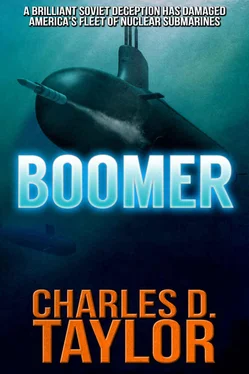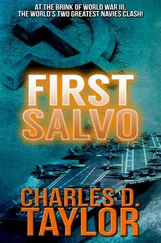
Charles Taylor is the bestselling author of thirteen naval action/adventure novels, primarily featuring the nuclear submarine service and the U.S. Navy SEALS. After serving as a Naval Reserve destroyer officer in the Atlantic and Caribbean, he followed a career in both educational and literary publishing. He currently divides his time between summers in Wyoming and winters on the Caribbean island of St. Croix.
In addition to discussing this book with a number of people, both military and civilian, I have read many books and military and professional journals. In attempting to translate numerous pages of my notes, I may inadvertently have used someone’s words or phrases in dialogue or in simplifying technical sections. I would like to both thank the authors for the impression they made on me and apologize if I have altered their original intent.
For those interested in naval affairs, I can highly recommend the Proceedings of the United States Naval Institute, an organization I have been a proud member of for more than twenty years; their naval publishing program is without peer. The finest book available on the U.S. submarine force is Silent Chase published by Thomasson-Grant, Inc., with photos and tent by Steve and Yogi Kaufman, the latter a retired vice admiral.
I would like to thank Dan Mundy and Bill Stritzler for their suggestions, Lieutenant Commander Jack Ward, USN, for coordinating one of my visits to New London, Bill McDonald for his never-ending interest in my books, Dominick Abel for managing the difficult role of agent and friend, Paul McCarthy for showing me how an editor’s talents can make all the difference in the world, and my wife, Georgie, for her critical help as she survived yet another manuscript — and me. And special thanks to Nelson DeMille for allowing me to borrow a superb idea from his book, The Charm School, After I had completed the manuscript and turned Wayne Newell loose on the world, Nelson was kind enough to allow me even greater justification for such a heinous character, whom you will appreciate even more after reading Mr. DeMille’s fascinating story.
Discovery
NEVADA NOW TWENTY-TOUR HOURS OVERDUE REPORTING
Impossible!
The odds of such … why, not even the Fates could be tempted in this manner!
Vice Admiral Mark Bennett stared blankly at the sheet of paper in his hand, no longer seeing the words. Instead, an image of Nevada — a blur at first, then a razor-sharp replica — swam before his eyes. He’d been aboard when she went on her initial sea trials. A fine submarine … a superb crew….
There was no reason to reread the message — he’d memorized those seven words instantly. Bennett was the single addressee — Deputy Chief of Naval Operations (DCNO), Undersea Warfare.
The originator, Rear Admiral Neil Arrow, was Commander Submarine Force, Pacific (COMSUBPAC). They were the closest of friends, classmates twenty-five years before at nuclear-power school, then six additional months at the same reactor. Arrow had sent the message under a security classification that he’d used only twice in his life, and both times to Bennett. For the second time that week Mark Bennett had been required to remove another onetime code from his safe, and once again he broke the message himself: NEVADA NOW TWENTY-FOUR HOURS OVERDUE REPORTING.
These six words might not have been nearly so ominous if a similar report hadn’t been received a little more than three days before, with equally frightening impact: ALASKA NOW TWENTY-FOUR HOURS OVERDUE REPORTING. And every four hours after that, following the rigid requirements defined for reporting such incidents, Arrow continued to confirm the fact that Alaska, a Trident ballistic-missile-firing submarine, was missing. Bennett had, of course, reported the situation to each individual in the chain of command with a critical need to know, ending with the President of the United States — eight men, no more. It was a relatively new procedure, secure, safe, and intended to reassure senior officers. But the loss of 192 strategic warheads, which each Trident carried, was hardly reassuring.
Two boomers, two nuclear-powered ballistic-missile submarines (SSBN’s), vital links in the strategic triad defending the United States, had now failed to respond to a critical one-time safety report from their stations at the scheduled time — Alaska for almost sixty-five hours now. It had been an experiment, designed to evaluate the security of a new communications system. Under normal conditions there was no such thing as an SSBN violating security to send a message, not even a one-time-burst transmission. It simply wasn’t necessary, not when stealth meant everything. Once an SSBN departed homeport and evaded her Soviet tails, she remained mute until returning home. She had to be in her assigned station because she hadn’t said she wasn’t. That’s the way the system functioned. It was that simple.
Initially, Alaska’ s failure was considered an equipment casualty. Communications gear had gone down at critical times in the past and it would again. This new system was untested under mission conditions, and the state of the world was deemed copacetic enough to run this single, critical test. So Arrow had instituted the standard procedures to reestablish contact with Alaska with a short, extra-low-frequency (ELF) query. Nothing. No response. Both admirals concurred there could be any number of causes — that there was no reason to be concerned — but this second message….
Admiral Bennett’s hand began to shake, but so slightly that he failed to notice the tremor even when the message slipped from his hand. He was shocked when he bent to pick up the paper and found it rattling between his fingers.
Bennett placed the message on his desk and smoothed it with his hands before depressing the button to the outer office. “Florence, would you please call Admiral Larsen’s office for me. Tell him I’ll be there in three minutes.” He would need the first two minutes in the head to compose himself before walking into Larsen’s office. Raymond Larsen may have been another close friend, but he was also Chief of Naval Operations and never overlooked a human weakness — especially from someone who might one day sit in his chair.
When he stepped from the private bathroom at the rear of his office, the red light was blinking on the interoffice communicator. “Yes, Florence.”
“Admiral Larsen has Secretary Kerner and two senators in his office now. He asked that you come by about noon.”
Bennett moved into the outer office and tapped his secretary on the shoulder. “Call back and tell him to throw out the senators. The Secretary can stay.” The Secretary of the Navy was part of the chain. “Tell him it’ll still be three minutes because I’m going to bring Admiral Newman with me.” Robbie Newman was Director, Naval Nuclear Propulsion, one of seven full admirals in the Navy at the time. Bennett was out the door before Florence had gotten the CNO’s office back on the line. Newman, who’d come from his Crystal City office, would be waiting outside Larsen’s office.
The Chief of Naval Operations’ office became deathly quiet after Mark Bennett explained as succinctly as possible that Nevada had now joined Alaska among the missing. Neither the Secretary of the Navy nor two of the Navy’s most senior admirals could find the correct words. They stared at each other, eyes shifting from one individual back to another as if one of them would suddenly come up with an answer. It was a quirk of fate — if they hadn’t agreed to this experiment, just once.…
Читать дальше













